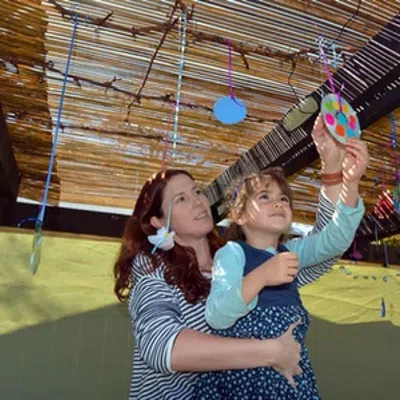
Sukkos and Simcha
(I wrote this for a general audience on www.mothersguidance.com, but thought I would share it here with you as well! If you like it, there is lots more over there! Chag Sameach!)
“I just want to be happy”, my student burst out. Although she was hoping I would excuse her from a challenging course, I knew that the secret to her happiness did not lie in another classroom, but rather in the relationships (with her teacher, classmates, and subject material), she could and would forge within her current situation.
A secret to happiness lies in the Jewish holiday of Sukkot which begins tomorrow evening and will be celebrated for seven days. The word Sukkot means booths or huts, hence the English name for Sukkot, Feast of Tabernacles. However Sukkot is also known as Zman Simchaseinu, the Time of Our Rejoicing since rejoicing on Sukkos is a Biblical imperative. Although the Torah commands us to rejoice on other holidays, (for example in Deuteronomy 16:11), on Sukkot it tells us to do so twice.
You shall rejoice in your festival, with your son and daughter, your male and female servant, the [family of the] Levite, the stranger, the fatherless, and the widow in your communities.
You shall hold a festival for your God seven days, in the place that Hashem will choose; for your God will bless all your crops and all your undertakings, and you shall have nothing but joy.
Deuteronomy 16:14-15
What is the secret of Sukkot’s joy? The Jewish people, collectively and individually, have spent the last forty-five days in an intense attempt to restore our relationship with God which inevitably is damaged through our distance, distractions, and sins. We prepared for Rosh Hashanah, the Day of Judgment for an entire month and then deepened our attempts in the ten days leading up to Yom Kippur, the Day of Atonement. Sukkot comes five days after Yom Kippur and it is a celebration of the joy of our restored relationship with God.
The very booths we sit in evoke a time when we followed Hashem into the wilderness and were sustained miraculously and directly by His love and care, as Sefer Vayikra (Leviticus) teaches:
You shall live in booths seven days; all citizens in Israel shall live in booths.
In order that future generations may know that I made the Israelite people live in booths when I brought them out of the land of Egypt—I, your God, Hashem.
Leviticus 23:42-43
In addition to recalling previous times of closeness on Sukkot, we also contemplate and pray for the ultimate redemption, when we will sit in the Sukkah of King David, in a state of harmony and connection both with Hashem and humanity.
It turns out that the secret to joy is connection and relationship. Sukkot is a time of joy because it is a season of closeness and love.
Our children (and students) may think that different teachers, vacation destinations, activities, clothing, or gadgets will bring them happiness. They need us to teach them that true joy isn’t found in externalities, but in the internal relationships we cultivate and develop.
This Sukkot, we can give our children a taste of authentic joy by giving them ourselves. Sit together, play games, sing songs, talk, eat and enjoy the feelings of closeness and connection. You will find yourselves rejoicing.
Chag Sameach! A joyous festival!
0 comments